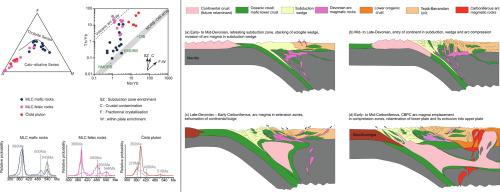Gondwana Research ( IF 6.1 ) Pub Date : 2021-07-14 , DOI: 10.1016/j.gr.2021.07.005 Piérig Deiller 1 , Pavla Štípská 1, 2 , Marc Ulrich 2 , Karel Schulmann 1, 2 , Stephen Collett 1 , Vít Peřestý 3 , Bradley Hacker 4 , Andrew Kylander-Clark 4 , Hubert Whitechurch 5 , Ondrej Lexa 3 , Eric Pelt 6 , Jitka Míková 7

|
Previously unrecognized mafic and felsic plutonic rocks, formerly interpreted as an anatectic part of the amphibolite-eclogite Mariánské Lázně Complex (MLC, Bohemian Massif) were examined together with a possible upper-crustal equivalent represented by the Čistá pluton intruding continental crust farther east. These plutonic rocks were studied by whole-rock geochemistry (major and trace elements, Sr-Nd isotopes) and zircon U-Pb geochronology. The MLC magmatic rocks range from pyroxene-amphibole gabbro to trondhjemite and oligoclasite. The Čistá pluton consists of porphyritic granitoids. The calc-alkaline nature of these rocks, relative enrichment of fluid-mobile elements (including large-ion lithophile elements), strong fractionation of light rare earth elements over heavy rare earth elements and depletion of high field strength elements are evidence for active margin magmatism. U-Pb zircon dating indicates that the magmatism was Mid-Devonian in both the MLC (ca. 385 Ma) and Čistá pluton (ca. 390 up to ca. 365 Ma). Both magmatic units show inherited cores probably linked to recycling of crustal material. Sr-Nd isotopic compositions indicate that the gabbro formed from a depleted MORB mantle source composition with a small contribution of a subduction and crustal component. A three-stage geodynamic model is proposed: 1) ca. 390–380 Ma recycling of a high-pressure accretionary wedge and migration of arc melts into more distal parts of the upper continental plate, 2) ca. 380–370 Ma compression and thickening of the accretionary wedge-arc edifice, and 3) ca. 370–365 Ma development of a giant east-dipping detachment that reworked the whole edifice in the west and also involved emplacement of the supracrustal Čistá pluton along antithetic west-dipping shear zone in the east. The studied magmatic rocks record a Mid-Devonian magmatic arc related to the formation of a subduction wedge stacked beneath the upper plate that was followed by formation of a second and independent Carboniferous continental arc further east.
中文翻译:

弧型岩浆侵入榴辉岩俯冲楔:波西米亚地块瓦里斯坎弧的最早记录
以前未被认识的镁铁质和长英质深成岩,以前被解释为角闪岩 - 榴辉岩 Mariánské Lázně 杂岩(MLC,波希米亚地块)的深熔部分,与可能的上地壳等效物一起进行了检查,该上地壳等效物由侵入更远东的大陆地壳的 Čistá 岩体为代表。通过全岩地球化学(主要和微量元素、Sr-Nd 同位素)和锆石 U-Pb 年代学研究了这些深成岩。MLC 岩浆岩的范围从辉石-角闪石辉长岩到长闪长岩和长石长石。Čistá 岩体由斑状花岗岩组成。这些岩石的钙碱性,流体流动元素(包括大离子亲石元素)的相对富集,轻稀土元素对重稀土元素的强烈分异和高场强元素的耗尽是活动边缘岩浆作用的证据。U-Pb 锆石测年表明 MLC(约 385 Ma)和 Čistá pluton(约 390 至约 365 Ma)的岩浆活动都发生在中泥盆世。两个岩浆单元都显示出可能与地壳物质再循环有关的继承核心。Sr-Nd 同位素组成表明辉长岩由贫化的 MORB 地幔源组成,具有少量俯冲和地壳成分。提出了一个三阶段地球动力学模型:1)ca。390-380 Ma 高压增生楔的再循环和弧的迁移熔化到上大陆板块的更远端部分,2)ca。380-370 Ma 对增生楔形弧形建筑物的压缩和增厚,以及 3) 约。370–365 Ma 开发了一个巨大的东倾支离体,改造了西部的整个建筑物,还涉及沿东部对立的西倾剪切带对上地壳 Čistá 岩体的就位。研究的岩浆岩记录了中泥盆世岩浆弧,与上板块下方堆积的俯冲楔的形成有关,随后在更东的地方形成了第二个独立的石炭纪大陆弧。



























 京公网安备 11010802027423号
京公网安备 11010802027423号